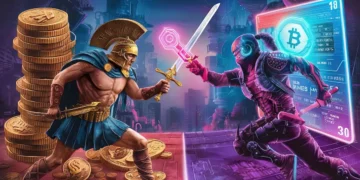The last six months in crypto markets have been dominated by two main narratives: the prospect of Bitcoin ETFs (which were finally approved by the SEC in January) and so-called real world assets (RWAs). Interestingly enough, these themes represent two sides of the same coin: Bitcoin ETFs take digitally-native assets off-chain, while RWAs bring traditional assets on-chain.
Both traditional and decentralized finance experts have hailed these related innovations. BlackRock CEO Larry Fink, for example, told CNBC, “ETFs are step one in the technological revolution in the financial markets. Step two is going to be the tokenization of every financial asset.”
So, what about Step Three?
I would argue that bringing the entire value chain, not just the end product, on-chain should be the final objective for all financial assets. That includes equities, fixed income, cash equivalents, alternative investments, and the many structured products that build on top of them.
Making digital assets available off-chain may have advantages. Bringing traditional assets on-chain might too. But this hardly scratches the surface of what blockchain can do for capital markets. Unparalleled efficiency, transparency, and programmability can be enabled from origination and issuance to settlement and custody. Bringing traditional assets on-chain is one thing; building them entirely on-chain is another.
This is already happening in small ways today. When users buy structured products that are natively built on-chain, they can issue, redeem, swap, and self-custody products permissionlessly, without dependencies on intermediaries. On-chain automation also enables rebalancing and reweighting for products to be self-sustaining. Anyone can independently verify the technology stack underpinning each product, minimizing trust and maximizing transparency. These capabilities can extend to all asset classes, not just the ones on-chain today.
Traditional financial firms like WisdomTree are already pushing past simple token wrappers and embracing broader blockchain capabilities for capabilities like settlement, record-keeping, and exchange infrastructure. J.P. Morgan Onyx is also exploring on-chain settlement and rebalance execution for alternative assets and broader portfolio management as well.
Blockchain-native organizations like Goldfinch and Maple are also bringing credit markets on-chain with lending facilities and secured collateral. Other asset classes like real estate (RealT), private equity (Tokeny), and carbon credits (Toucan) are coming on-chain too.
Granted, there is regulation to consider and technology to develop, but the collective opportunity to move beyond Bitcoin ETFs and tokenized RWAs is immense. In a future where all assets are built, managed, and distributed on-chain, investors, asset managers, and even regulators will benefit from the transparency, efficiency, and disintermediation that results. Lower costs, global distribution, and more efficient markets await on the other side.




















































































where can i buy cheap clomid without dr prescription how can i get clomid no prescription where can i buy generic clomid pill buy generic clomiphene pill where buy clomid tablets buy clomid without prescription acquista clomid online
I couldn’t turn down commenting. Well written!
I am in point of fact delighted to glance at this blog posts which consists of tons of worthwhile facts, thanks for providing such data.
buy azithromycin 500mg generic – flagyl 400mg oral order metronidazole 200mg pill
buy semaglutide 14 mg without prescription – order rybelsus 14 mg without prescription periactin 4mg generic
domperidone buy online – order tetracycline sale cyclobenzaprine 15mg cost
inderal without prescription – propranolol canada oral methotrexate 10mg
buy amoxicillin generic – diovan 160mg pill brand ipratropium 100mcg
azithromycin usa – tindamax oral buy nebivolol 5mg for sale
amoxiclav pills – atbioinfo buy acillin sale
buy cheap generic nexium – https://anexamate.com/ buy nexium 40mg online cheap
buy coumadin online cheap – blood thinner losartan ca
buy mobic 15mg for sale – https://moboxsin.com/ buy meloxicam 7.5mg generic
deltasone 40mg drug – https://apreplson.com/ prednisone 40mg over the counter
amoxicillin tablet – combamoxi.com cost amoxil
buy fluconazole 100mg generic – https://gpdifluca.com/ buy diflucan no prescription
escitalopram ca – anxiety pro lexapro uk
cenforce price – buy cheap generic cenforce cenforce 100mg over the counter
what happens when you mix cialis with grapefruit? – https://ciltadgn.com/# canadian pharmacy ezzz cialis
sildenafil vs tadalafil which is better – on this site cialis directions
order zantac 150mg – order ranitidine online cheap ranitidine 300mg canada
The vividness in this tune is exceptional. synthroid espaГ±a
This is a question which is forthcoming to my callousness… Numberless thanks! Quite where can I upon the contact details an eye to questions? buy amoxicillin tablets
More posts like this would persuade the online play more useful. https://ursxdol.com/sildenafil-50-mg-in/
Proof blog you procure here.. It’s hard to find strong calibre article like yours these days. I truly recognize individuals like you! Withstand mindfulness!! https://prohnrg.com/product/get-allopurinol-pills/
More posts like this would create the online elbow-room more useful.
https://doxycyclinege.com/pro/sumatriptan/
More articles like this would remedy the blogosphere richer. http://bbs.51pinzhi.cn/home.php?mod=space&uid=7059342
purchase dapagliflozin without prescription – https://janozin.com/# forxiga tablet
xenical medication – https://asacostat.com/# orlistat where to buy
Thanks for putting this up. It’s evidently done. https://lzdsxxb.com/home.php?mod=space&uid=5113093